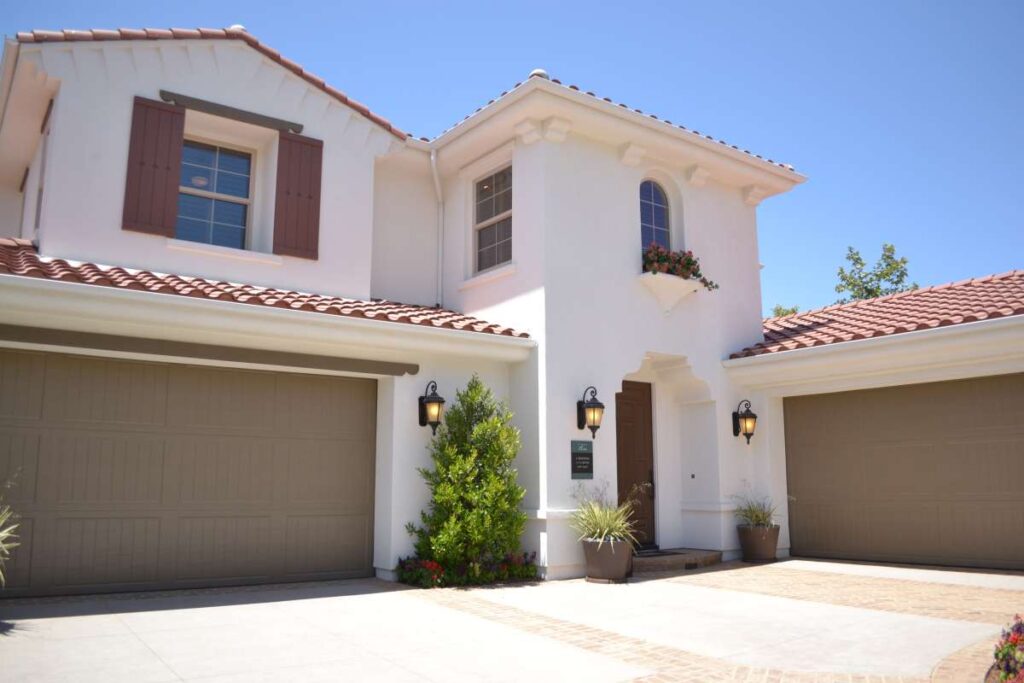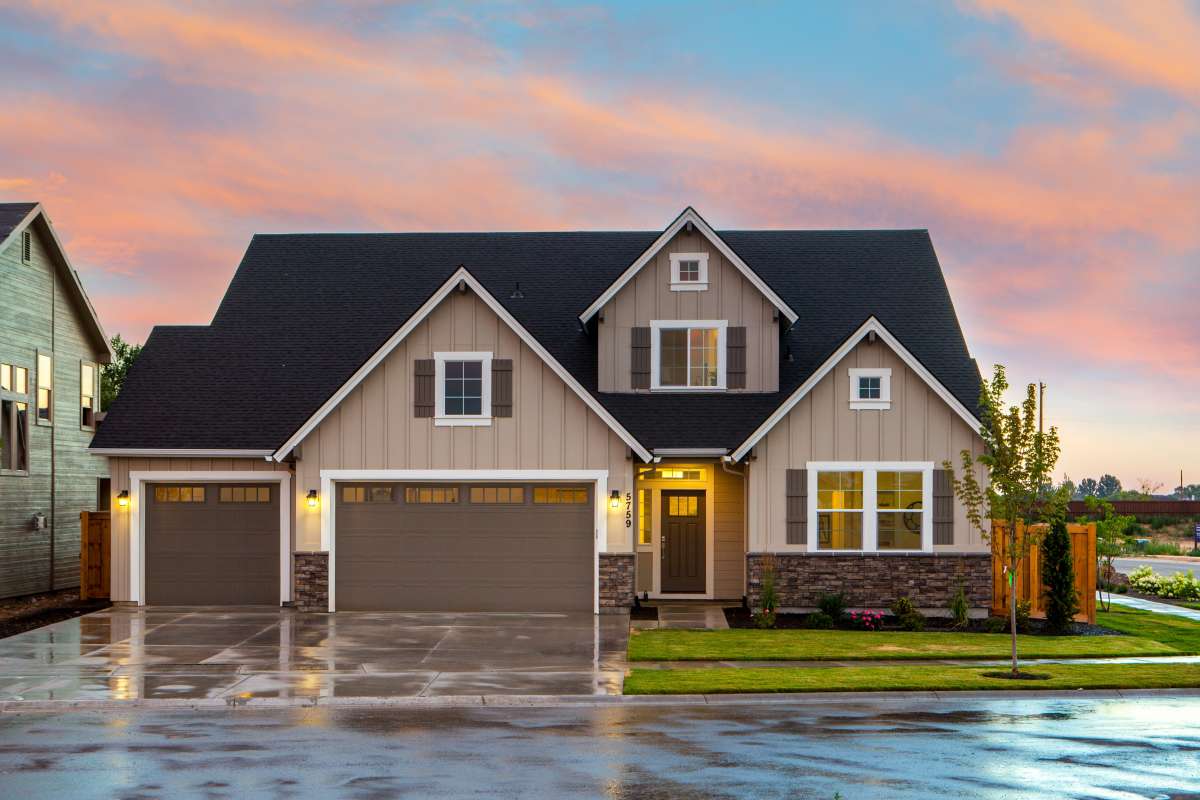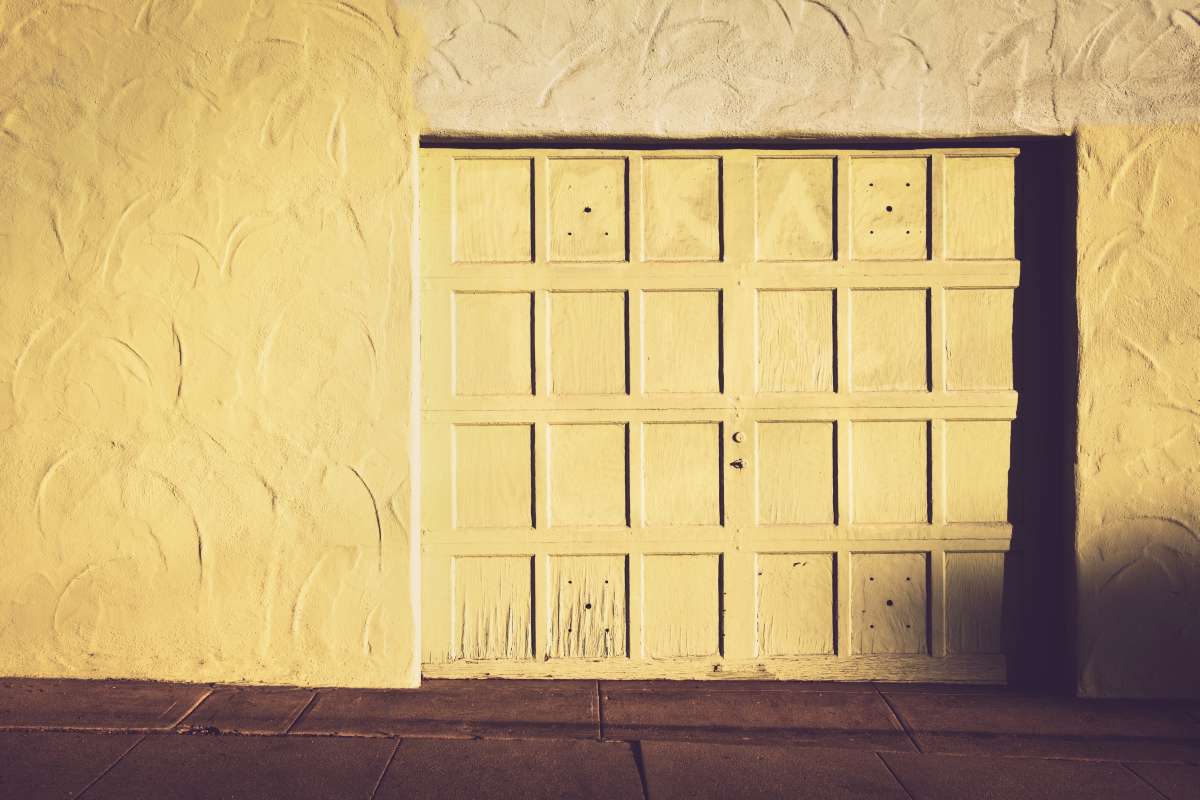Choosing the right garage door for your home can be a daunting task. There are so many different styles, types and materials to choose from that it may seem overwhelming.
Whether you’re a new homeowner or are refreshing the look of your existing home, buying a garage door is an exciting opportunity for you to breathe new life into your home’s exterior.
Many homeowners replace their garage door once in their lifetime, so finding the perfect mix of function, fashion, and affordability is an essential part of the process.
If you don’t know where to start, you’ve come to the right place to learn how to pick the right garage door for your home.
To help you make the decision best for your home, our buying guide offers a collection of garage door information below, including overviews of garage door styles, materials, Insulation, brochures, garage door comparisons and more. Are you getting frustrated by your clutter and garage organisation? Here at Garage Storage Solutions, we offer extensive professional organising and declutter service.
What To Consider When Choosing A Garage Door
When shopping for a garage door, here are a few steps you can take to help narrow down your selection:
Determine The Dimensions Of Your Door
Measure the height and width of your door frame.
Determine Your Budget
Several factors influence the price of a garage door. First, there are various materials available, from the more affordable steel to the more elegant wood.
There are also many options for customising doors. However, the size of the door and the material are the two factors that most influence the price.
Steel is one of the more affordable materials. However, wood garage doors are more expensive; the cost depends on the wood type and treatment.
Look At Many Garage Styles
Most garage doors fall into one of three style categories — raised-panel, carriage house or contemporary.
Take a look at examples of each and see which one style goes best with that of your home, as the garage door you choose will significantly impact the look and feel of your home.
It’s also a good idea to research their material makeup and maintenance requirements.
Decide How You’ll Use The Space.
Will you park your car in your garage, or are you planning to use it as a living space? How you intend to use this space will help you select a door that best suits your needs.
It will also help determine the insulation capacity needed for your garage door, measured by R-value.
The higher the R-value, the higher the thermal efficiency of your door. A door with a high R-value will keep heat inside during the winter months and cool air inside during the summer months.
If you plan to spend lots of time in your garage, we recommend choosing a garage door with a higher R-value.
A well-insulated garage door is also essential if the living space is next to or above the garage.
Garage Door Material
Choosing the most appropriate material for your garage door will depend on various factors, including the climate where you live, your lifestyle and your visual tastes.
Deciding on the material is one way to narrow down your selection. For example, three popular materials for garage doors are:
Wood
Wood has historically been the traditional material for garage doors. Homeowners looking to give their homes a rustic appearance often opt for this material.
Just like wooden floors, wooden garage doors have a beautiful appearance and offer a sophisticated look.
It’s easy to customise, as wood can easily be cut into any shape or size that you request, and it’s resilient, so it’s not going to dent under pressure.
Steel
Steel doors are a popular option among homeowners who want an attractive door without all the maintenance requirements of their wooden counterparts.
They have a modern, sleek look, and they’re relatively affordable but don’t require much maintenance.
With the nearly endless designs and styles available, there are many customisation options.
Faux Wood
Another option is a door with faux wood overlays that emulate the beautiful texture of natural wood, such as cypress and mahogany.
These doors also feature a strong, energy-efficient insulated steel base and boast an impressive R-value of 20.4.
Garage Styles That Match Your Home
Garage doors are a prominent feature of a home’s exterior and make up a third of the entire front facade.
So it is well worth your while to give much thought to this feature. If you make the right choice, your garage door style will complement the style of your house.
Like there are nearly countless home styles, there are also many styles of garage doors. Below we’ll go over the most common types available:
Raised-panel
This is a popular style of garage doors — so popular that they’ve become the standard and the kind that comes to most people’s minds when they think of garage doors. Raised-panel doors are often made of steel and feature R-values ranging from 6.3 to 18.4.
Carriage Style
This is another popular style that works well with a variety of different home styles.
Generally speaking, they mimic the appearance of the doors of old carriage houses, but it is not uncommon to find them even in contemporary homes.
Although the original carriage doors were manually swung open from the centre, modern carriage doors open conventionally and still offer the same charm and beauty as the original doors.
Also known as “barn style garage doors,” carriage doors have a unique look that pops and can complement homes of various craftsmen or mission styles.
Contemporary Or Modern
Classic functional details and clean lines characterise contemporary garage doors.
One popular customisation option for this style is tempered glass panels, which can be clear, frosted or tinted, and frames made of aluminium.
These doors go particularly well with modern home designs that feature high-tech materials and clean lines. These doors are particularly suitable for mid-century or modern-style homes.
Modern steel is another popular material for contemporary doors. These doors come in flush or grooved panels with various finish options, including several wood-grain textures.
Things To Know Before Buying A Garage Door
A good garage door will last decades, maybe even a lifetime. So it makes sense to spend a little extra time and effort making the best choice possible and avoid cheap garage doors.
Get An ‘in-person’ Quote.
Ordering a garage door over the phone or online is asking for trouble.
Every garage is a little different, and a knowledgeable salesperson will check details like opening size and shape, headroom and side clearance, and even help you make design decisions.
And if something does go wrong, there won’t be any question about whose fault it is.
So make sure you get a salesperson to come to your house and check out the situation before ordering a door.
Beware Of Wood Doors
Natural wood doors look fantastic when they’re new. But unless you’re willing to devote time and money to maintenance, they won’t look good for long.
Natural finishes last a few years before they need recoating. And if you wait too long, you’ll have to sand off all the finish and start over to get your door looking new again.
The good news is, you can get the look of wood for a fraction of the cost and avoid the maintenance nightmare as well.
The least expensive option is embossed steel with a faux wood-grain finish (less than$1,000).
From a distance, these doors look remarkably similar to natural wood. However, if you’re willing to spend more ($2,500 and up), consider a garage door with a wood composite overlay or a fibreglass skin.
Composites offer the look of natural wood with the longevity and stability of plastic when you shop garage doors.
Upgrade Your Insulation
Suppose you’re planning to buy an insulated door because you want to save energy or keep your garage warm. In that case, it’s worth spending about 15 to 20 per cent extra to upgrade from extruded polystyrene to polyurethane insulation.
The insulating effectiveness of a garage door is its R-value. The larger the number, the better it insulates.
Upgrading from 2-in. polystyrene to its Intellicore (polyurethane) raises the insulating value from R-9 toR-18. That’s a lot of bang for the buck.
Pay A Little More For Beefier Springs
Springs are what help your garage door go up quickly and come down slowly. Most garage doors use torsion springs.
You can usually see these coiled torsion springs above the door. Standard torsion springs are rated for about 10,000 cycles.
That may sound like a lot, but if you open and close your door six times a day, which is pretty average, you’ll reach 10,000 cycles in less than five years.
When you shop garage doors, spending an extra $50 will buy you a spring rated for 20,000 cycles, twice the life for a few bucks more.
Buy A New Opener At The Same Time
The same person who installs your new door can also install a new garage door opener.
Your opener will fail eventually, so if it’s showing age or you want a quieter opener or one with more features, it is time to replace it.
Replacing it along with the door will probably save you money on labour, and you may even be able to negotiate a package deal on the new door and opener.
Think Twice About Installing Your Door
You could save a few hundred dollars by installing the door yourself, but it’s one DIY project that doesn’t have a big payoff.
Here’s why. For starters, there’s a ton of parts, and it’ll take you at least a full day to put them together.
Plus, winding the spring calls for special tools and lots of arm strength and is pretty dangerous.
If you hire a pro to install the door, the new entry will be delivered and the old one hauled away, and the job will be done in about four hours. And you’ll have someone to call if there’s a problem.
Use Manufacturers’ Websites To Choose A Door Design
When you shop garage doors, you don’t have to guess how a particular style and colour of the door will look on your house when you check garage doors for sale online.
Most manufacturers have software on their websites to upload a photo of your garage and add any garage door style.
This lets you choose a door style, including the design features you like, pick windows and colour, and even add hardware.
You can play around with different styles until you find one you like. Then print out the specs for an accurate price quote from your dealer to help you find cheap garage doors.
Choose Windows Wisely
You might be surprised how much better a garage door looks with the right windows. And beyond adding style, windows can supply much-needed light to the garage interior. Here are a few tips for choosing glass:
- If your garage is heated, upgrade to insulated glass.
- For extra privacy and security, install the glass in the top panel.
- Match the glass style to your house windows if possible.
- If your garage door opener has angled rather than square corners, don’t install glass that goes behind them. It might look awkward.
Need A Quiet Door? Look For These Features
If you have an attached garage and want to minimise the racket caused by the garage door going up and down, choose a door with polyurethane insulation and nylon rollers.
The garage door insulation dampens any vibrations that would usually be amplified by uninsulated steel.
And nylon rollers are quieter than metal ones. If you’re also planning to replace the garage door opener, look for an opener with a belt drive. Again, they’re quieter than other types. Garage Storage Solutions features an innovative wall storage system with heavy-duty sliding wall components such as hooks, garage shelving and stylish, durable steel cabinets designed to hold your gear securely and neatly in place.
Dos And Don’ts Of Choosing A New Garage Door
Do Select The Right Style.
If a worn-out garage door can leave a first-time visitor with a wrong impression of your home, the opposite must hold as well.
Upgrading your garage door will enhance the visual appeal not only of the garage but of the entire exterior.
Here’s the key: Select a door style that complements your house. For instance, if you live in a Craftsman bungalow—distinguished by deeply overhanging eaves, extensive woodwork, and divided-light windows, look for a garage door that features the same hallmark characteristics.
Meanwhile, if you live in a clean-lined modern home, concentrate on simple garage door designs with limited detailing, which will reinforce the streamlined appeal of the architecture.
A successful selection looks right at home on the exterior rather than sticking out like a sore thumb and calling attention to itself.
Garage door manufacturers offer no shortage of options, or if you have a specific vision, you can even design a custom door to your exact specifications.
Don’t Forget Insulation.
Many homeowners use the garage as their primary entrance. If you’re one of them, consider an insulated garage door.
For one thing, Insulation ensures greater comfort in the garage. In fact, on a cold day, a well-insulated door can keep the garage 10 to 20 degrees warmer, according to a study conducted by a residential garage door manufacturer.
It’s not all about comfort, though. There are savings at stake, too, because as the largest opening in the home, the garage door can affect your home’s overall energy efficiency.
In a home with conditioned living spaces next to and above the garage, a poorly sealed, an uninsulated garage door can make the home’s climate-control system work harder (and consume more energy) to maintain the target temperature.
By minimising drafts and thermal energy transfer, an insulated garage door can help lower monthly utility bills.
That said, much depends on the quality of the Insulation. To understand the insulating capacity of a garage door, consult its listed R-value. The higher the R-value, the better the door’s performance.
Do Choose A Practical Door Type.
Different types of garage doors operate in different ways. For example, traditional swinging doors open outward from a central split, while others slide right to left like the entrance to an old barn.
Far and away, one type surpasses the others in terms of popularity— overhead sectional doors.
There are a couple of reasons why homeowners favour the convenience of an overhead sectional design.
For one, in contrast to swing-style doors, which require ample clearance, sectional doors roll up and down on mounted tracks.
And, overhead sectional doors are easy to pair with an automatic garage door opener.
That’s not to say you can’t automate other types of garage doors, but doing so typically entails a higher cost.
You can get the best of worlds. For example, many garage door companies offer models like old-fashioned carriage house doors but operate with modern overhead convenience.
Don’t Ignore Care Requirements.
As a hardworking component of today’s home, the garage door must be adequately maintained to look and perform its best.
Certain construction materials require more care than others. For instance, while there’s no denying the beauty of natural wood, some homeowners avoid it because it requires periodic refinishing.
Other materials offer the look of wood with considerably less upkeep.
Composite—a combination of wood fibres and synthetic resins—emulates the look of wood but provides superior durability and won’t rot, warp or crack. Steel is a great option no matter where you live.
But if you’re near the coast, you’ll need to wax your door like you would a car to prevent surface rust.
The best advice is to understand the upkeep requirements of any door on your radar and not commit to purchasing one that you’re unable or unwilling to take care of.
Don’t Underestimate Severe Storms.
Due to their large size, garage doors are especially vulnerable to high winds.
If a tornado or hurricane manages to break through the garage door, the resulting surge in air pressure can produce destructive, if not devastating, consequences.
Unfortunately, there’s no such thing as a windproof garage door.
But in many areas prone to severe storms, the municipal government requires code-compliant doors that can withstand a minimum level of wind resistance.
To determine whether such regulations apply in your neck of the woods, consult with county officials or a local garage door dealer.
Wind-rated garage doors cost more than non-reinforced models, but there’s no discernible difference in exterior appearance.
The heavy-duty parts that lend extra strength—reinforced struts, for example, or upgraded springing—are all inside the garage, behind the door itself.
In other words, there’s no need to sacrifice curb appeal for storm preparedness or vice versa.
Do Experiment With Visualisation Tools.
At the start of your search, it’s a good idea to visit a dealer showroom to get a sense of how different door styles and construction materials look and feel.
Once you’ve narrowed your choices down to a few options, it can be helpful to experiment with an online visualisation tool. Tools like this often make it easier to arrive at a final decision and add a bit of fun to the process. Can I find garage storage cabinets to match my style? Absolutely! Even the cabinets in the garage should reflect your unique tastes and style. Garage Storage Solutions offers stylish storage in a variety of materials and finishes.


